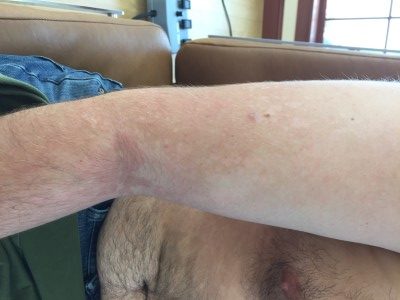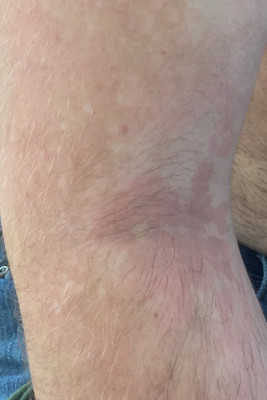Tinea Versicolor
5 Answers to Common Questions about this Condition
What is this discolored rash on my chest, back, and arms? Tinea versicolor, otherwise known as pityriasis Versicolor, is a harmless but cosmetically disturbing rash that is most often seen on the trunk, arms, and neck. It is sometimes itchy, but not always. It can be a variety of colors, thus the name “Versicolor.” In pale-skinned individuals, it usually appears pink or brown. In dark-skinned individuals, it usually appears paler than the surrounding skin.


1-What causes it? Tinea versicolor is caused by an overgrowth of a yeast called pityrosporum ovale, which is a harmless yeast that normally grows to some extent on everyone’s skin, so it is not really contagious. It is not the same as Candida yeast, and it is not a fungus. In some people, the yeast overgrows. Usually, overgrowth is stimulated by excessive sweating and moist, oily conditions.
2-If it is harmless, do I need to treat it? Not really, but yes. A confusing answer, I know. Most people who leave it untreated eventually have a rash on their entire trunk. It will become itchier and disfiguring in time.
3-Why does it cause discoloration? And why is it different colors on different people? The red comes from inflammation in the skin triggered by the yeast. The tan or brown is a result of thickening and scaling of the skin in response to the yeast. Both of these resolve quickly with treatment. The pale discoloration or what dermatologists call hypopigmentation (less pigment) is more stubborn. The yeast temporarily stuns the pigment cells and slows the production of pigment. This is exacerbated by sun exposure, often leaving a “tan line” that will not even out until the tan is gone.
4-How can I prevent overgrowth of the yeast? For those who are prone to overgrowth of the yeast, washing the body 1-2 times a week with Selsun Blue shampoo will reduce the overgrowth of the yeast. However, a visible rash usually requires topical or oral anti-yeast medications. I have seen a number of young women with this condition who are actively using tanning beds, so please stay out of those tanning beds.
5-How do the pills work? For patients with extensive rash, the application of topical medication for a few weeks is often impractical. So, sometimes we use pills to treat this condition. However, it can be difficult for the anti-yeast medication to get from the mouth to the skin. So, here’s the trick: We recommend patients take the pills, wait about one hour, then sweat profusely AND leave the sweat on for about 8 hours. We do this once and repeat it in about two weeks. Gross and stinky, but it works.
Remember, even after the condition is treated, it may take 6-12 weeks or more for the discoloration to resolve, so be patient during treatment.
For more information, these are some additional helpful resources from the American Academy of Dermatology.
If you know someone who may find this article helpful, please share it with them! Follow us on social media this week, and subscribe to our growing YouTube channel!
If you would like to receive these posts in your email inbox, Subscribe to our Site.
|